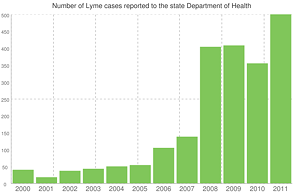Published December 7, 2011 at 11:50 a.m.
While Vermont sportsmen spend November and December hunting deer, Lyndon State College biology professor Alan Giese is busy hunting deer ticks. He tromps through the woods armed with a white flannel sheet, waving it like a flag over brush so the fabric picks up specimens.
It may not sound scientific, but Giese is surveying five locations along the Connecticut River for deer ticks, potential carriers of Lyme disease, for what he hopes will become Vermont’s first systematic tick-population study. He wants to assign hard data to a trend that scientists and public health officials have observed for years: the spread of deer ticks — and Lyme disease — throughout Vermont.
Giese and a student research assistant started their work last spring. They had planned to be done by now, but, thanks to an unusually warm autumn, the research project and its blood-sucking subjects have stayed active longer than normal this year.
“We expected them to shut down in mid-November, and they haven’t,” Giese says, noting that fall is peak season for adult-stage deer ticks. Giese warns that ticks won’t go underground until night temperatures drop below freezing — and stay there. Meterologists are forecasting warm weather for much of the next week.
A decade ago, Lyme was virtually unheard of in Vermont. In 2000, the state Department of Health recorded just 40 cases, two-thirds of them likely contracted out of state. Yet by 2009, there were 408 confirmed and probable cases, with three-quarters of them determined to have originated in Vermont.
After several years of climbing Lyme rates, 2010 saw a slight dip, to 356 cases, and health officials cautiously hoped that better prevention was causing the disease rates to plateau.
Instead, 2011 is shaping up to be the worst year yet: As of last week, there were more than 500 confirmed and probable cases, according to Erica Berl, an epidemiologist with the Vermont Department of Health.
“It had seemed like things were leveling off, so it’s a little concerning that things are going up again,” says Berl. “But one year does not a trend make. We don’t know if it will continue.”
Better detection and diagnosis are probably responsible for some of this year’s increase, Berl says, but there’s no question that deer ticks — and Lyme — are spreading north.
What’s responsible for the uptick? Several scientists point to Vermont’s healthy deer population, which has surged with the reforestation of agricultural land. When a female deer tick feeds on the protein-rich blood of a deer, it yields more eggs than from the blood of other animals, explains state entomologist Jon Turmel.
Turmel suspects the higher incidence of Lyme in 2011 is due to last winter’s heavy snowfall — snow cover has an insulating effect for ticks — and relatively mild temperatures.
“Last year we got a good snow cover before it got really cold,” Turmel says. “And we didn’t have those two weeks in January where it got to 20 below. So I think they overwintered well.”
Another theory attributes the spread of Lyme to global warming. Turmel is skeptical of that explanation, but Giese says it makes logical sense.
“Our winters are less severe,” Giese says. “They start later and end earlier, giving ticks a longer season to do their thing, more time to find a host.”
With his research assistant, Giese has been sweeping for ticks at sites in Ascutney, Thetford, Newbury, Barnet and Lancaster, N.H. His preliminary results confirm that deer ticks are slowly marching northward. At southern survey sites such as Thetford, Giese says a single 100-meter transect could pick up literally hundreds of deer ticks. In far northern Lancaster, that same sweep yielded a maximum of two ticks — sometimes none at all.
“It seems like ticks have sort of exploded,” Giese says. “Five to eight years ago, you hardly ever saw them, and suddenly — boom — they are everywhere.”
Giese also turned up “tantalizing circumstantial evidence” consistent with a study done in Maine that suggests deer ticks are more prevalent in areas with invasive shrubs such as honeysuckle and buckthorn. If nothing else, Giese hopes that might open a new front in Vermont’s war on invasive species.
“If we couldn’t motivate people to get rid of invasives by other means, we’ll scare the hell out of them with Lyme disease,” he says. “Get out the machetes and hack the stuff down!”
Lyme disease is transmitted by bites from deer ticks, officially known as,black-legged ticks, infected with the bacteria Borrelia burgdorferi. The first U.S. case was documented in Lyme, Conn., in 1975; the disease has since spread from Maine to Virginia, and as far west as California. Vermont diagnosed “sporadic” cases of Lyme in the 1980s, says Berl, the state epidemiologist. But it wasn’t until 2006 that the state started to witness a sudden, dramatic increase (see sidebar).
Most infections stem from ticks in the nymph stage because they are small enough — no bigger than a poppy seed — to go unnoticed until they are engorged with blood, 24 to 48 hours after latching onto a host. No solid data exist on the percentage of deer ticks infected with Lyme, but the state health department estimates it’s around 20 percent in Vermont.
Symptoms of early-stage Lyme disease begin days or weeks after infection and are similar to the flu: chills, fever, headache and muscle pain. If left untreated, Lyme can lead to long-term brain and neurological problems, such as memory disorders, nerve damage, numbness, and sleep and vision problems. Not all infections come with Lyme’s signature “bull’s-eye” rash, which can make diagnosis more challenging.
Turmel, the state entomologist, says the state lacks the funds to conduct comprehensive tick monitoring along the lines of what Giese is doing, but it has conducted numerous passive surveys. For three years, officials from the Vermont Department of Forest, Parks and Recreation camped out at 30 deer check-in stations around the state on opening weekend of rifle season and plucked ticks off deer. From 2002 to 2004, the state Department of Health and Agency of Natural Resources asked veterinary clinics to report ticks removed from dogs. All year round, the general public sends tick samples to Turmel and his colleagues for identification.
While commending those efforts, Giese says tick surveillance in Vermont has historically been “spotty,” making it hard to compare data sets. Giese hopes his research will produce more concrete science on how ticks and Lyme are migrating across the state.
More By This Author
Speaking of...
-

Regulators Are Poised to Let Vermont Gas Buy Methane From a Distant Landfill
Oct 21, 2022 -

Video: Gail and George Africa of Vermont Flower Farm Plan to Retire
Sep 8, 2022 -

Under New Ownership, Turtle Fur Plans to Expand Its Offerings
Aug 1, 2022 -

Video: Talking Trees With Burlington Arborists
May 5, 2022 -

Increasing Downpours Impede Efforts to Improve Lake Champlain's Water Quality
Aug 18, 2021 - More »
Comments
Comments are closed.
From 2014-2020, Seven Days allowed readers to comment on all stories posted on our website. While we've appreciated the suggestions and insights, right now Seven Days is prioritizing our core mission — producing high-quality, responsible local journalism — over moderating online debates between readers.
To criticize, correct or praise our reporting, please send us a letter to the editor or send us a tip. We’ll check it out and report the results.
Online comments may return when we have better tech tools for managing them. Thanks for reading.














































